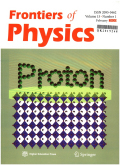Dense skyrmion crystal stabilized through interfacial exchange coupling:Role of in-plane anisotropy
基本信息来源于合作网站,原文需代理用户跳转至来源网站获取
摘要:
A Monte Carlo simulated-annealing algorithm was used to study the magnetic state in an in-plane helimagnet layer on triangular lattice that exchange couples to an underlayer with strong out-of-plane anisotropy.In the single helimagnet layer with in-plane anisotropy(K),the formation of labyrinth-like domains with local spin spirals,instead of parallel stripes,is favored,and these domains rapidly transform into dense skyrmion crystals with increasing interfacial exchange coupling(J'),equivalent to a virtual magnetic field,and finally evolve to an out-of-plane uniform state at large enough J'.Moreover,with increasing K,the skyrmion crystal state can vary from regular 6-nearest-neighboring circular skyrmion arrangement to irregular squeezed skyrmions with less than 6 nearest neighbors when the in-plane anisotropy energy is higher than the interfacial exchange energy as the skyrmion number is maximized.Finally,we demonstrated that the antiferromagnetic underlayer cannot induce skyrmions while the chirality inversion can be achieved on top of an out-of-plane magnetization underlayer with 180° domain walls,supporting the experimental findings in FeGe thin film.This compelling advantage offers a fertile playground for exploring emergent phenomena that arise from interfacing magnetic skyrmions with additional functionalities.

推荐文章
Snowball Earth at low solar luminosity prevented by the ocean–atmosphere coupling
Faint Young Sun paradox
Carbon dioxide
Earth system
Siderite
一维SOC晶格中In-plane Zeeman场驱动的量子相变
in-plane Zeeman场
密度矩阵重整化群
自旋轨道耦合
Fermi-Hubbard模型
一个基于Exchange的企业办公自动化系统的实现
办公自动化
B/S结构
ASP技术
Exchange
基于Microsoft Exchange 2000的音视频域间组播实用传输系统
Mucrisift Exchange 2000
组播
音视频
域间
内容分析
关键词云
关键词热度
相关文献总数
(/次)
(/年)
引文网络
引文网络
二级参考文献 (0)
共引文献 (0)
参考文献 (35)
节点文献
引证文献 (0)
同被引文献 (0)
二级引证文献 (0)
1958(1)
- 参考文献(1)
- 二级参考文献(0)
1960(1)
- 参考文献(1)
- 二级参考文献(0)
1980(1)
- 参考文献(1)
- 二级参考文献(0)
1997(1)
- 参考文献(1)
- 二级参考文献(0)
2001(1)
- 参考文献(1)
- 二级参考文献(0)
2004(1)
- 参考文献(1)
- 二级参考文献(0)
2011(1)
- 参考文献(1)
- 二级参考文献(0)
2012(1)
- 参考文献(1)
- 二级参考文献(0)
2013(6)
- 参考文献(6)
- 二级参考文献(0)
2014(1)
- 参考文献(1)
- 二级参考文献(0)
2015(8)
- 参考文献(8)
- 二级参考文献(0)
2016(3)
- 参考文献(3)
- 二级参考文献(0)
2017(4)
- 参考文献(4)
- 二级参考文献(0)
2018(1)
- 参考文献(1)
- 二级参考文献(0)
2019(3)
- 参考文献(3)
- 二级参考文献(0)
2020(1)
- 参考文献(1)
- 二级参考文献(0)
2021(0)
- 参考文献(0)
- 二级参考文献(0)
- 引证文献(0)
- 二级引证文献(0)
引文网络交叉学科
相关学者/机构
期刊影响力
物理学前沿
主办单位:
高等教育出版社
出版周期:
双月刊
ISSN:
2095-0462
CN:
11-5994/O4
开本:
出版地:
北京市朝阳区惠新东街4号富盛大厦15层
邮发代号:
创刊时间:
语种:
eng
出版文献量(篇)
1093
总下载数(次)
0
总被引数(次)
1881
期刊文献
相关文献
推荐文献

 免费查重
免费查重










